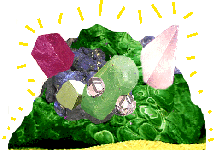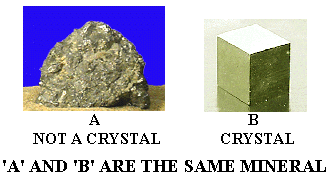 | "Welcome to Crystal City, Lou!" |
 |
 | "Thanks, Lulu! So what goes on in Crystal City!" |
 | "We make crystals! Crystals are minerals that have grown into regular, geometric solids bounded by flat faces! Crystals are unusual! In most cases, minerals grow into irregular, random shapes!" |
 |
 | "So what's the story?!" |
 | "It's all in the atoms! Many substances are composed of atoms that are randomly arranged (glass is an example.) Such substances are called 'amorphous'! But in minerals, the atoms are arranged in an orderly fashion! They form a regular, repeated pattern, like old-fashioned wallpaper! Such substances are called 'crystalline'!" |
 |
 | "That's cool! But if all minerals are crystalline, why aren't they all crystals? I mean, look at the mineral grains in this enlarged picture of a rock! Most of them don't have regular shapes. They are highly irregular!" |
 |
 | "What you need to know is how minerals form and grow!! Atoms with opposite electric charges are drawn towards each other! If they get close enough, they arrange themselves into regular patterns and attach (bond) themselves to each other! The result is a grain of the crystalline substance we call a mineral! " |
 |
 | "As more and more atoms arrive and bond to each other, the pattern keeps extending and the mineral grain grows and grows! In the case shown in the picture, the atoms add themselves evenly on all sides of the grain. The result is that the shape of the grain is regular and stays the same as growth occurs!" |
 |
 | "So if the mineral grain stops growing at stage 3, its external shape is regular, and the grain is a crystal!! Groovy! But I must ask again, why aren't all mineral grains crystals!??" |
 | "Think about this situation...!! There's a hole in a rock in which three mineral grains are growing! Each of the grains has a regular, geometric shape and is a crystal! What does the future hold??" |
 |
 | "Well, if I look into my crystal ball (heh heh!), I see the three crystal grains growing and growing...until they bump into each other or hit the rock!!" |
 |
 | "Eventually, the hole is filled! The three mineral grains remain crystalline (their atoms are arranged in a regular pattern), but their outlines have become irregular! So the grains are not crystals any more!!" |
 |
 | "Now I've got another question! How come the crystals of different minerals (and sometimes even crystals of the same mineral) may have different shapes?!" |
 | "Good question! It has to do with the patterns in which the atoms are arranged!! Here you have a square as a basic unit of pattern! (The basic unit of pattern is called a 'unit cell'.) As the unit cell is repeated, the pattern (called a 'space lattice') is built up!" |
 |
 | "Now we'll put atoms at the corners of the squares!" |
 |
 | "And to make it a bit fancier, now we'll put other atoms in the centers of the squares!" |
 |
 | "And if we extend the space lattice into the third dimension, this is what we get - a large cube made up of cubic unit cells! That's the pattern for the mineral halite!" |
 |
 | "If you stack the unit cells in a different way, you get a different overall shape!" |
 |
 | "And let's add atoms to that!" |
 |
 | "OK! I see that if you stack the squares different ways, you get different shapes! That would explain how minerals that have their atoms arranged in the same way can have different crystal shapes! But what if your unit cell is not a square!?" |
 | "Quite right, Lou!" |
 | "Take a look at this!" |
 |
 | "And extend the pattern into the third-dimension, and add atoms to it - and we get calcite!" |
 |
 | "So you get different crystal shapes because you have different unit cell shapes and because you can stack the unit cells different ways! Coolo! But one last question, Lulu! Where does all this take place? Where in nature are atoms roaming around, getting together, building crystals!?" |
 | "Lots of places! In evaporating salt water; in magma chambers; in heated, solid rock; and even in the air - like when it snows! But that's another story! I hope you've enjoyed your visit to Crystal City!" |